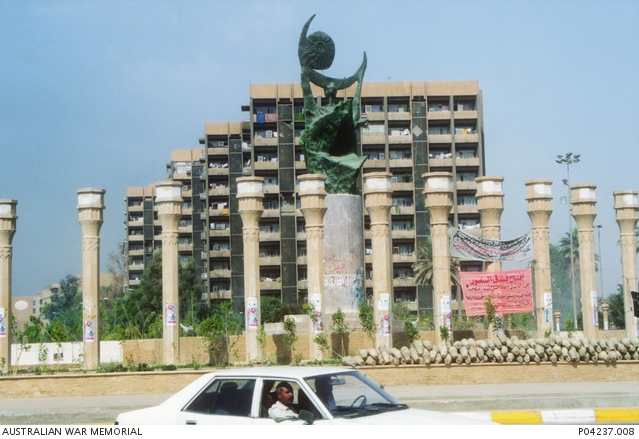Australians in Iraq 2003: Current situation
- War in Iraq
- Political debate at home
- The RAN in the Persian Gulf
- RAN clearance divers
- The SAS in Iraq
- Special forces group
- The RAAF in Iraq
- Australians in Baghdad
- Current situation
- Official war artists
After the overthrow of Saddam Hussein’s Baath Party regime, a United States–led Coalition Provisional Authority (CPA) was set up to govern the country, alongside a 25-member Iraqi Governing Council. In June 2004, it has been agreed, the CPA will hand over power to a Transitional National Assembly and Iraq will regain its sovereignty. A permanent government, elected in accordance with a new constitution, is due to take over in 2005.
In early 2004, Australia still had 850 personnel in the Middle East. HMAS Melbourne was in the Persian Gulf, while RAAF C-130 Hercules and P-3 Orion aircraft were operating in the region. RAAF air traffic controllers remained at Baghdad airport, and soldiers provided security for Australian diplomatic and government personnel. Australians were also helping train the new Iraqi armed forces.
However, the situation in Iraq remains tense. A brutal resistance movement remains active, targeting coalition members, ordinary Iraqis, and international institutions, including the United Nations and the Red Cross. These repeated attacks threaten both political progress and the physical rebuilding of the country’s infrastructure. Establishing a stable Iraq remains a daunting task.
Under Saddam Hussein’s rule, hundreds, possibly thousands, of political prisoners were executed or tortured at Abu Ghraib prison, on the outskirts of Baghdad. Coalition forces found 993 unmarked graves at the prison. George Gittoes visited the site on 28 April 2003.
On 27 October 2003, the first day of Ramadan, a car-bomb exploded outside the Red Cross headquarters in Baghdad. Gittoes, who was nearby and took this photograph of the scene, commented: “it was the day humanitarianism became a target absolute ground zero for the human spirit”.
This fibreglass statue, photographed on 25 October 2003, was created by Iraqi artists as a symbol of unity. It replaced a large statue of Saddam Hussein which had dominated the area.


